


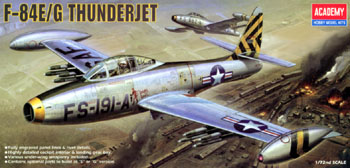 Academy's
1/72 F-84E/G Thunderjet
Academy's
1/72 F-84E/G Thunderjet
By Chris Banyai-Riepl
History
The straight-winged F-84 was the ground-attack workhorse of the Air Force during the Korean War, being called upon to attack just about anything. Like most Republic aircraft it was extremely robust and could take quite a bit of punishment. This robustness, coupled with an easy flying manner helped put the F-84 into the air forces of a great number of post-WW2 European countries including France, Norway and Denmark.
The Kit
Probably the best summary of this kit is "Wow!" Even if you don't build 1/72 you should go out and buy this kit, as it is an excellent example of what a model should be. Of course everyone will be wanting to know how this kit stacks up next to the Tamiya 1/72 F-84, so I'll line these two kits up side-by-side and see what happens.
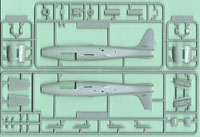 First
off, though, the Academy kit is an F-84E/G. This alone makes it better
than the Tamiya kit. To make it an E you get separate fuselage panels
for the blow-in doors, two types of dive brakes, a braced and an unbraced
canopy, two types of tailpipe ends, and an insert for the wing to give
you a refueling receptacle. Instead of this, the Tamiya kit gives you
an open gun bay.
First
off, though, the Academy kit is an F-84E/G. This alone makes it better
than the Tamiya kit. To make it an E you get separate fuselage panels
for the blow-in doors, two types of dive brakes, a braced and an unbraced
canopy, two types of tailpipe ends, and an insert for the wing to give
you a refueling receptacle. Instead of this, the Tamiya kit gives you
an open gun bay.
Starting with the interior, the Tamiya kit has a slight edge on the instrument panel/rudder pedal assembly, while the cockpit tubs are pretty close in terms of detailing. The seats are also the same, resulting in neither kit really being on top in the interior arena. Once it's all painted and detailed, either kit will look very good.
Moving to the rest of the interior, both kits have taken the route of incorporating the nosewheel well into the intake splitter, and both do it very well. One nod to Tamiya, though, is that they have the nose gear doors separate, while the Academy kit has them molded with the bay. The jet exhaust is nicely done in both kits, but the Academy kit definitely has the edge over the Tamiya kit here as they've provided the exhaust as an open-ended tube with the back end of the engine closing off one end. The Tamiya kit has an insert for the back end of the engine and a bit of fiddling is needed to get the same look. Granted, these are extremely small nits to pick, but that's what you get when you compare two kits of this quality.
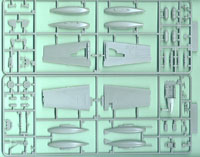 Outside,
the fuselage detailing in both the Academy and Tamiya kits are finely
recessed and match up almost exactly, although the Academy kit looks to
be a bit longer than the Tamiya kit. Which is right I don't know and I'll
leave the final determination up to the micrometer police. Both fuselages
have their iffy-fit areas, although the Tamiya kit is a bit better in
this area as all you have to worry about is fitting the gun panel on,
while the Academy kit has those fuselage panels and the separate tail
ends to worry about. Test fitting, though, shows the fuselage panels to
fit quite well and the tail piece should be no problem either. It might
be best to affix both of those pieces before the fuselage halves are together
to achieve the best possible fit.
Outside,
the fuselage detailing in both the Academy and Tamiya kits are finely
recessed and match up almost exactly, although the Academy kit looks to
be a bit longer than the Tamiya kit. Which is right I don't know and I'll
leave the final determination up to the micrometer police. Both fuselages
have their iffy-fit areas, although the Tamiya kit is a bit better in
this area as all you have to worry about is fitting the gun panel on,
while the Academy kit has those fuselage panels and the separate tail
ends to worry about. Test fitting, though, shows the fuselage panels to
fit quite well and the tail piece should be no problem either. It might
be best to affix both of those pieces before the fuselage halves are together
to achieve the best possible fit.
This takes us up to the wings. Tamiya, Academy, it doesn't matter. In fact, you could take the bottom wing from the Academy kit and glue it to the top wing of the Tamiya kit and not notice anything different other than the color of the plastic. The Academy kit has the tip tanks separate, while the Tamiya kit has them molded to the wing. Also, the Academy kit has the wingtip refueling probes mounted to the tanks, while these are not present on the Tamiya kit. And to do an F-84E there is a separate insert in the wing to remove the refueling receptacle in the Academy kit. Again, the fit looks to be excellent so no worries there. Wheel well detailing is the same in both kits: superb.
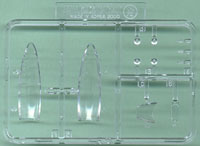 The
landing gear is beautifully detailed in both kits, with the Tamiya kit
getting a slight nod in the nose gear arena by having a separate wheel
(the Academy's is molded with the strut). The main gear is almost identical,
although the Academy struts look a bit more robust. Wheels are almost
the same between the two. Underwing stores are definitely an Academy win,
with bombs, rockets, and drop tanks provided to Tamiya's bombs and drop
tanks.
The
landing gear is beautifully detailed in both kits, with the Tamiya kit
getting a slight nod in the nose gear arena by having a separate wheel
(the Academy's is molded with the strut). The main gear is almost identical,
although the Academy struts look a bit more robust. Wheels are almost
the same between the two. Underwing stores are definitely an Academy win,
with bombs, rockets, and drop tanks provided to Tamiya's bombs and drop
tanks.
Another plus of the Academy kit is the choice of either open or closed speed brakes, with a fully detailed well included. Since this kit allows you to do either an E or a G, two canopies are provided as well; one framed and one unframed. Gunsight glass, tip tank lights and landing lights round out the clear tree. And finally, the Academy kit includes a stand. A stand? Yes, a stand. Memories of a bygone era, to be sure.
 The
decals are very nicely done as well, with two USAF choices and one French
choice, all in natural metal. While not as colorful as the Tamiya choice,
they do offer something a bit different. The first one is an F-84E of
the 8th FBS, 49th FBG in Korea 1951. The second is an F-84G from the same
squadron, this time in Japan in 1955. The French example has no additional
information included, but it's colorful as well with yellow and black
wingtip tanks and black bands on the wings.
The
decals are very nicely done as well, with two USAF choices and one French
choice, all in natural metal. While not as colorful as the Tamiya choice,
they do offer something a bit different. The first one is an F-84E of
the 8th FBS, 49th FBG in Korea 1951. The second is an F-84G from the same
squadron, this time in Japan in 1955. The French example has no additional
information included, but it's colorful as well with yellow and black
wingtip tanks and black bands on the wings.
Conclusion
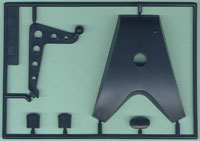 We
now have two excellent 1/72 F-84 kits on the market. The big question
is which one to get? Well, if you want to build an F-84E the answer is
obvious: Academy. But if you want to build an F-84G it's a toss-up. Building
the Tamiya kit might be a bit quicker as you don't have to worry about
attaching all the G panels, but you do have to worry about the open gun
bay. If that's what you want, though, then the Tamiya kit is the one for
you. Otherwise, the only real choice comes down to price, and right now
the Academy kit is retailing for a few bucks less than the Tamiya one,
at least in the US. Elsewhere it may be different, so the end result is
buy whichever one is cheapest in your neck of the woods and you'll be
happy. Now if Academy will just continue the line and put out an F-84F
and RF-84F....
We
now have two excellent 1/72 F-84 kits on the market. The big question
is which one to get? Well, if you want to build an F-84E the answer is
obvious: Academy. But if you want to build an F-84G it's a toss-up. Building
the Tamiya kit might be a bit quicker as you don't have to worry about
attaching all the G panels, but you do have to worry about the open gun
bay. If that's what you want, though, then the Tamiya kit is the one for
you. Otherwise, the only real choice comes down to price, and right now
the Academy kit is retailing for a few bucks less than the Tamiya one,
at least in the US. Elsewhere it may be different, so the end result is
buy whichever one is cheapest in your neck of the woods and you'll be
happy. Now if Academy will just continue the line and put out an F-84F
and RF-84F....

Previous: Contents







